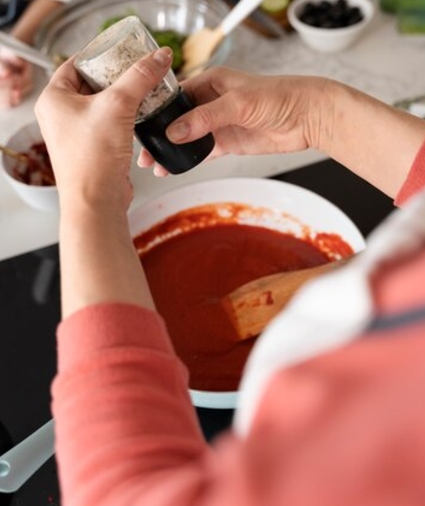A Taste of Tradition
The essence of Italian cooking is embodied by the dish spaghetti, which requires no introduction. Its adaptability and simplicity have won hearts all over the world, elevating a routine dinner to a remarkable one. Spaghetti’s brilliance is its versatility, which allows it to be served with a variety of flavors and occasions, whether it’s topped with meatballs, a rich tomato sauce, or just garlic and olive oil.
What You Can Learn From This Recipe?
Learn how to make the ideal al dente spaghetti, balance the flavors in a traditional tomato sauce, and comprehend the secret to making a pasta meal that is smooth and restaurant-caliber.
What I Love About This Recipe
This recipe’s simplicity is what sets it apart. Spaghetti lets its components’ inherent flavors take center stage. It’s always the ideal go-to dish that never lets me down, whether I’m entertaining guests or just seeking comfort food.
What’s the Best Way to Store Leftovers?
Any leftover spaghetti can be kept in the refrigerator for up to three days in an airtight container. To restore the texture of the sauce, reheat it slowly on the stovetop or in the microwave with a little water added.
What to Serve With It?
For an Italian-inspired dinner, serve this spaghetti with a glass of red wine, a crusty loaf of garlic bread, and a fresh green salad.
Spaghetti: A Timeless Classic
Description
A culinary icon, spaghetti embodies the essence of Italian cooking. This adaptable dish offers a hearty supper for any occasion by combining precisely cooked pasta with a tasty and rich tomato-based sauce. Spaghetti's simplicity, flavor, and versatility make it a popular choice for both weeknight meals and celebratory get-togethers. Spaghetti always looks great, whether it's topped with Parmesan cheese, fresh basil, or a little olive oil.
Ingredients
Instructions
Preparing the Spaghetti and Sauce
-
Cook the Pasta
- Fill a large pot with water and bring it to a boil. Add a generous pinch of salt.
- Cook the spaghetti following the instructions on the package until it’s al dente.
- Drain the pasta, but save about 1/2 cup of the pasta water, then set the pasta aside.
-
Prepare the Sauce
- Heat olive oil in a large skillet over medium heat.
- Add minced garlic and onion, sautéing until fragrant and translucent.
- Stir in the crushed tomatoes, dried oregano, and chili flakes. Simmer the sauce for 15-20 minutes, stirring occasionally.
- Season with salt and black pepper to taste.
- Adjust the thickness with reserved pasta water if necessary.
-
Combine and Serve
- Toss the cooked spaghetti into the skillet with the sauce, mixing well to coat each strand.
- Sprinkle with fresh basil and Parmesan cheese. Serve immediately.
Nutrition Facts
Servings 4
- Amount Per Serving
- Calories 400kcal
- % Daily Value *
- Total Fat 10g16%
- Saturated Fat 2g10%
- Cholesterol 5mg2%
- Sodium 500mg21%
- Potassium 800mg23%
- Total Carbohydrate 65g22%
- Dietary Fiber 5g20%
- Protein 12g24%
* Percent Daily Values are based on a 2,000 calorie diet. Your daily value may be higher or lower depending on your calorie needs.
Note
- For a richer sauce, add a splash of red wine while cooking the tomatoes.
- Feel free to add vegetables like mushrooms or zucchini for a heartier meal.
Journey of Spaghetti: The String of Culinary Heritage
With its straightforward yet enduring appeal, spaghetti is more than just a culinary item; it is a cultural icon with origins in Italian heritage. This exploration of spaghetti's past demonstrates how it changed from a simple, everyday food to a well acclaimed meal that is served at tables all over the world.
The Origins of Spaghetti
Pasta itself is the origin of spaghetti, having existed for thousands of years. Although some people believe Marco Polo may have brought pasta to Italy following his 13th-century trips to China, historical evidence indicates otherwise. The Mediterranean was already home to early pasta varieties; as early as the 12th century, Sicily recorded a dry noodle-like dish. Modern spaghetti originated from these early pasta strands manufactured from durum wheat.
The name "spaghetti" was initially used in the 19th century and comes from the Italian word spago, which means "string" or "twine." Unlike other pasta varieties, its thin, cylindrical shape made it adaptable and simple to prepare. Spaghetti, which represents the versatility and inventiveness of Italian cooking, eventually became a mainstay in Italian homes.
A Dish Born of Necessity
The main component of classic spaghetti, durum wheat, grows well in the sunny Mediterranean region. Spaghetti's characteristic chewiness and suppleness are caused by its high gluten level. Pasta drying was a useful method of long-term food preservation in an era before refrigeration. Because of its longevity, spaghetti was a popular among travelers and sailors who needed to eat during lengthy trips.
Spaghetti was introduced to new countries by Italian immigrants who migrated throughout the world in the late 19th and early 20th centuries. Its versatility and affordability swiftly made it a popular meal all across the world.
The Art of the Sauce
These days, spaghetti and tomato sauce go along so well that it's difficult to picture one without the other. But it wasn't until the 16th century that tomatoes were transported from the Americas to Europe. Despite initial mistrust, tomatoes finally emerged as a key component of 18th-century Italian food.
It was a revelation when pasta and tomato sauce were combined. Herbs like oregano and basil enhanced the dish, while the acidity of the tomatoes counterbalanced the pasta's richness. With varieties that include meatballs, shrimp, and vegetables, spaghetti became a canvas for culinary innovation as a result of this union of flavors.
Spaghetti on the Global Stage
Spaghetti is a staple in kitchens all around the world because of its ease of preparation and adaptability. During the flood of Italian immigration in the late 19th and early 20th centuries, spaghetti became quite popular in the United States. An American-Italian innovation, spaghetti with meatballs has come to represent comfort cuisine and is praised in family dinners, restaurants, and movies.
Spaghetti has been reinvented with regional flavors throughout Asia. In the Philippines, spaghetti is sweetened with banana ketchup and served at birthday celebrations, whereas in Japan, it is turned into naporitan, a meal flavored with ketchup and sausage. Every culture contributes something special, emphasizing spaghetti's versatility and allure.
Why Spaghetti Remains Timeless
Because it strikes a balance between simplicity and refinement, spaghetti has a distinct place in the culinary world. It's sophisticated enough for a romantic dinner but simple enough for a fast weeknight supper. In several cultures, its long, continuous strands represent immortality, which gives its enjoyment an additional level of significance.
Millions of people perform the everyday process of twirling spaghetti around a fork, which ties us to a centuries-old custom. Spaghetti can be served with a rich marinara, a creamy Alfredo, or even just garlic and olive oil. The options are unlimited.
Fun Facts About Spaghetti
- World Spaghetti Day: October 25th is celebrated as World Spaghetti Day, a tribute to this beloved dish.
- Record-Breaking Bowl: The largest bowl of spaghetti ever made weighed over 13,000 pounds!
- The Fork Technique: Italians believe in twirling spaghetti with a fork alone—no spoons needed.
A Culinary Bridge Between Cultures
The story of spaghetti demonstrates how food unites people and crosses boundaries. From its modest origins as dried pasta, it has developed into a dish that stands for coziness, imagination, and community. Enjoying a meal of spaghetti is part of a custom that has been carried down through the ages, bringing people together via their love of delicious cuisine.
We appreciate your exploration into spaghetti's delectable journey!




